
18th Century Provincial Louis XV Walnut Tombeau Shape Commode
A provincial Louis XV walnut commode, mid 18th century, of 'Tombeau' shape, the rectangular top with slightly serpentine front and moulded edge above three long drawers, on shaped feet and aprons, the sides panelled, 85 cm high, 126 cm wide, 65 cm deep

Louis XV Style Ebonised Commode with Gilt Metal Accents
A Louis XV style ebonised commode, the three double drawers with decorative pierced gilt metal escutcheons and drop ring handles above a carved serpentine skirt, 83 cm high, 106 cm wide, 60 cm deep

Louis XV Walnut Commode En Tombeau with Maltese Cross Inlay
A Louis XV walnut commode En Tombeau, the moulded top above three long drawers and a shaped apron inlaid to the centre with a Maltese cross in a roundel, standing on lion paw feet, height 87 cm, width 132 cm, depth 63 cm

Kingwood and Brass Bombe Commode in Louis XV Style
A kingwood and brass mounted bombe commode, in the Louis XV style, the shaped black marble top above two drawers inlaid 'Sans traverse' with radial veneers, having brass chutes, handles and sabots, height 81 cm, width 103 cm, depth 51 cm
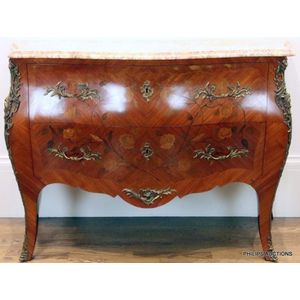
Louis XV Style Inlaid Tulipwood Bombe Commode by Haentges Freres
A Louis XV style inlaid tulipwood bombe commode by Haentges Freres, Haentges Freres (Paris), mid 20th century the fine commode with a variegated ochre and pink marble serpentine top above two long shaped drawers decorated with a flower bouquet inlay to…

Louis XV Style Commode with Marble Top and Ormolu Mounts
Louis XV style commode chest of drawers with marble top and ormolu mounts, 72 cm wide, 38 cm deep, 77 cm high
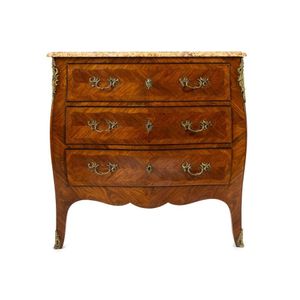
Louis XV Style Kingwood Commode with Marble Top, circa 1930
A Louis XV style marble top kingwood commode, circa 1930, with a purple and ochre serpentine surface above three long drawers with feather banding and book end veneers, with foliate handles and escutcheons, the hipped edges above angled tapering feet with…

Louis XV Painted Commode, French, Late 18th Century, Serpentine Form
A Louis XV painted commode, French, late 18th century, of serpentine form with an arrangement of three drawers, 87 cm high, 124 cm wide, 57 cm deep

Louis XV Walnut Bombe Commode with Grey St Anne Marble
A Louis XV walnut bombe commode, the Grey St Anne marble top above two short and two long drawers with moulded fronts and cast brass handles, above a shaped apron on shaped legs, height 85 cm, width 128 cm, depth 66 cm

Louis XV Marquetry Bombe Commode with Rose Spray Inlay
A Louis XV kingwood and tulipwood marquetry bombe commode, the shaped breccia marble top above two long drawers inlaid 'Sans traverse' with a spray of roses in marquetry framed by ormolu mounts on cabriole legs with foliate and cabochon ormolu chutes and…

Inlaid Tulipwood Commode with Gilt Bronze Mounts
A Louis XV style inlaid tulipwood bombe commode, c1930 with a shaped variegated yellow marble top above two long drawers, decorated with panel of trailing floral motif, the apron with drop and hipped edges flowing to curvaceous legs, gilt bronze cast…

Louis XV Floral Marquetry Bombe Commode
A small Louis XV period floral and foliate marquetry walnut and kingwood veneered bombe commode, French 18th/19th century 85 cm high, 75 cm wide, 36 cm deep

Red Lacquer Chinoiserie Commode with Ormolu Mounts
Louis XV style ormolu mounted red lacquer Chinoiserie commode, the serpentine marble top above two sans traverse long drawers, decorated with landscapes in gilt, on cabriole legs, height 82 cm width 96 cm depth 52 cm

18th Century Louis XV Walnut Commode
A Provinicial Louis XV walnut commode, mid 18th century, the shaped rectangular top with moulded edge above two drawers, raised on cabriole supports, the drawer front and sides decoratively moulded, 89 cm high, 130 wide, 60 cm deep

Louis XV Style Marble Top Bombe Commode
A Louis XV style marble top tulipwood bombe commode, circa 1930 with a shaped ochre and rouge marble top above two long drawers with floral inlay to bookend strung reserves, raised on hipped cabriole legs and embellished throughout with cast bronze mounts…

Louis XV Style Parquetry Commode with Marble Top
A small Louis XV style marble topped kingwood parquetry commode, late 19th century with a mottled rouge marble top of serpentine profile above two drawers with parquetry panels and blonde wood stringing, the sides conforming, a shaped drop and hipped legs…

Inlaid Tulipwood Bombe Commode with Gilt Bronze Mounts
A Louis XV style inlaid tulipwood bombe commode, circa 1930, the fine commode with a serpentine mottled cream and purple marble top above two long shaped drawers with floral inlay to bookend veneers, similarly decorated to the sides, with a shaped drop,…

Louis XV Style Walnut Commode with Bronze Mounts
A Louis XV style walnut and tulipwood commode, late 19th century, of serpentine outline, the breccia marble top above two drawers, on cabriole supports, the drawer fronts and sides geometrically veneered and with bronze mounts, 87 cm high, 109 cm wide, 55…

Louis XV Walnut Commode with Carved Details
A French Provincial Louis XV style walnut three drawer commode with shallow serpentine front, carved drawer fronts and scroll cabriole legs, circa 1910, 73 cm high, 70 cm wide, 40 cm deep.
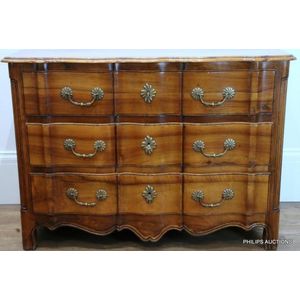
Cherrywood Commode with Louis XV Style
A Louis XV style cherrywood commode, circa 1930s of serpentine profile, the rectangular top with bullnose edge above three long drawers, the curvaceous apron with drop and raised on short cabriole legs with whorl feet, with brass swan neck handles and…
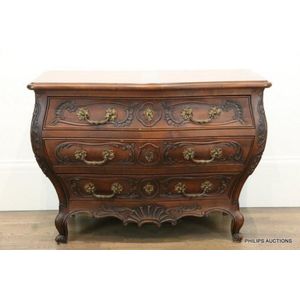
Cherry Wood Bombe Commode with Gilt Brass Handles
A Louis XV style bombe style cherry wood Bordelaise commode, circa 1930, the commode with three bow fronted serpentine drawers, with gilt brass handles and escutcheons, decorative mouldings, on short, scrolled Feet, height 86 cm, width 118 cm, depth 61 cm

Louis XV style inlaid tulipwood bombe commode
A fine Louis XV style inlaid tulipwood bombe commode, circa 1930's With a serpentine br che d'Alep marble top above two long shaped drawers with floral inlay to a striking veneered sunray design, the sides with a similar sunray decoration, with a shaped…

Louis XV Style Bombe Commode with Marble Top
A Louis XV style kingwood and tulipwood commode, mid-20th century, the bombe commode with a shaped red and grey marble top with a moulded edge, above three long drawers with quarter veneer paneling, with a shaped apron, hipped edges and curvaceous legs,…

Louis XV Walnut Commode, French 1760
A Louis XV walnut commode of three long drawers, French circa 1760, 137 cm wide, 64 cm deep, 81 cm high

Louis XV Walnut Bombe Commode, 18th Century
A stunning Louis XV period carved walnut bombe commode, French mid 18th century, 90 cm high, 60 cm deep, 120 cm wide
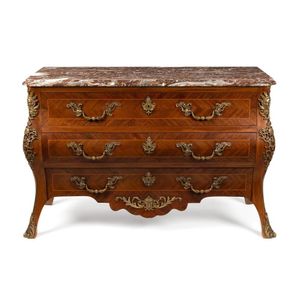
19th Century Louis XV Style Walnut Commode with Marble Top
A large Louis XV style marble topped walnut commode, 19th century, with a rouge marble top above three long drawers with book end feather banding and stringing, quarter veneer panelling to the sides, a serpentine skirt and raised on splayed legs, with…
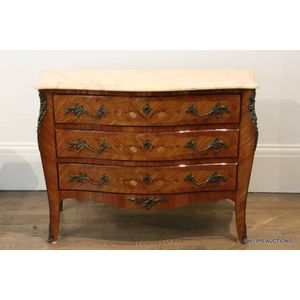
Tulipwood Bombe Commode with Floral Inlay and Marble Top
A Louis XV style tulipwood commode, mid 20th century, the tulipwood bombe commode with a shaped yellow marble top above three long drawers with quarter veneer, paneling with floral inlay enclosed by stringing, with a shaped apron, hipped edges and…

Yellow Ochre Bombe Commode with Parquetry Inlay and Gilt Bronze
A Louis XV style bombe commode, circa 1930's, with a serpentine top in yellow ochres above two full width parquetry inlaid drawers with gilt bronze handles and escutcheons, hipped front legs decorated with gilt bronze mounts and sabots, height 84 cm,…

Serpentine Bombe Commode with Parquetry Inlay and Gilt Bronze
A Louis XV style bombe commode, circa 1930's, with a serpentine top in yellow ochres above two full width parquetry inlaid drawers with gilt bronze handles and escutcheons, hipped front legs decorated with gilt bronze mounts and sabots, height 86 cm,…

18th Century Provincial Walnut Bombe Commode
Louis XV provincial bombe walnut commode, 18th century, the parquetry top above two short and two long drawers, with rocaille ormolu escutcheons and handles, raised on scrolled feet, height 86 cm width 132 cm depth 70 cm. Provenance: Baron Edson Antiques,…

Louis XV Walnut Commode with Ornate Brass Embellishments
A Louis XV walnut commode, two half drawers over two full width, elaborate brass handles and keyhole escutcheons, ormolu embellishment, variegated marble top. 130 x 64 x 84 cm.

Walnut Commode with Variegated Marble Top and Brass Handles
A Louis XV walnut, flat front commode, variegated marble top over three full width drawers, brass handles and keyhole escutcheons, raised on curved carved feet. 132 x 74 x 87 cm.

Serpentine Walnut Commode with Rocaille Handles
A Louis XV walnut serpentine commode, having two short above two long drawers all with carved panel fronts with rocaille brass handles and escutcheons, a central hidden drawer and a scroll and flower carved apron, flanked by cabriole legs with scroll toes…

Louis XV Commode with Gilt Bronze Mounts
A Louis XV transitional style kingwood commode, 19th century, of serpentine outline, the variegated marble top above two drawers, the drawer fronts and sides veneered in diaper lattice pattern, the mounts gilt bronze, height 76 cm, width 80 cm, depth 39 cm

19th Century Louis XV Style Bombe Commode
A Louis XV style fruit wood bombe commode, 19th century, the serpentine top above three long drawers raised on scroll carved cabriole legs, 82 cm high, 100 cm wide, 52 cm deep

Louis XV Style Tulipwood Bombe Commode with Marble Top
French Louis XV style tulipwood bombe commode chest of drawers, with marble top and ormolu mounts, 100 cm wide, 45 cm deep, 81.5 cm high

Louis XV Style Tulipwood Bombe Commode with Marble Top
A large Louis XV style tulipwood bombe commode, circa 1930s, with a serpentine marble top in yellow ochre and purple colours above parquetry decorated two short and two long drawers, the sides of conforming design, with hipped legs and decorated with gilt…

Louis XV Style Tulipwood Commode with Marble Top
A Louis XV style tulipwood and parquetry bombe commode, circa 1930s, with a serpentine purple and ochre marble top above two drawers decorated with a diamond and trellis design within strung cartouches, similarly decorated to the sides, with a dropped…

Chinoiserie Commode with Marble Top
Louis XV style marble top commode chest of drawers with lacquered finish and chinoiserie decoration, 121 cm wide, 53 cm deep, 84 cm high

Louis XV Kingwood Parquetry Commode, 1750
A Louis XV Kingwood parquetry commode, circa 1750. veneered in kingwood a quatre faces, crossbanded and with fillets, the sides of serpentine form with recessed back angles and inlaid with lozenge-shaped panels to the sides, containing two drawers and a…

Louis XV Style Ormolu Mounted Marble Top Commode
A French Louis XV style 2 drawer commode early 20th century having extensive ormolu mounts and a variegated marble top. Width 105 cm, depth 49.5 cm

Louis XV Style Walnut Commode with Floral Marquetry
A fine French Louis XV style walnut and floral marquetry decorated three drawer marble top commode with ormolou mounts. 87 cm high, 70 cm wide, 37 cm deep.

Inlaid Tulipwood Bombe Commode with Yellow Marble Top
A Louis XV inlaid tulipwood bombe commode, circa 1930s, with a curvaceous yellow marble top, two long drawers with book end veneers enclosed by leafy scrolling borders and sprigged with flowers, the sides similarly decorated, raised on hipped and tapering…

Louis XV Style Tulipwood Bombe Commode
A Louis XV style tulipwood bombe commode, circa 1930s, with a serpentine mottled ochre marble top above two drawers inlaid with floral motifs to shaped and strung bookend veneers enclosed by darker toned veneers, similar to the sides, a shaped apron with…

Cherrywood Commode, Louis XV Style, 1930s
A Louis XV style cherrywood commode, circa 1930s, of serpentine profile with three long drawers with shaped fielded panels, the curvaceous apron with drop and raised on short cabriole legs with whorl feet, with brass swan neck handles and foliate…

Louis XV Walnut Commode - 95x126x60 cm
A Louis XV walnut commode, 95 cm high, 126 cm wide, 60 cm deep
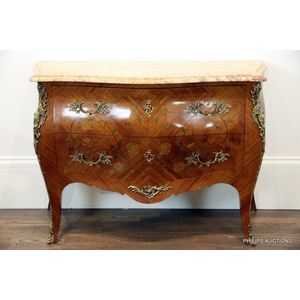
Louis XV Style Inlaid Tulipwood Bombe Commode
A Louis XV style inlaid tulipwood bombe commode, circa 1930, with a mottled yellow ochre top of serpentine profile, two long drawers with floral inlay to quarter veneer panels, the sides conforming, a shaped apron with drop and hipped edges flowing to…

19th Century Mahogany Marquetry Commode
Louis XV transitional style mahogany and marquetry commode, 19th century, grey marble top of serpentine outline, above three crossbanded and burr walnut drawers, sides with similar marquetry, raised tapering legs with sabots, height 93 cm, width 147 cm,…

Louis XV Inlaid Marble Top Commode
French Louis XV style inlaid marble top petit commode, set with a rouge marble top above a drawer and bombe shaped door, all beautifully inlaid with flowers, raised on slight cabriole legs, 92 cm x 69 cm x 40 cm

Louis XV Style Bombe Commode with Floral Inlay
A Louis XV style marble top tulipwood bombe commode, circa 1930, with a shaped top above two long drawers with floral inlay to bookend strung reserves, raised on hipped cabriole legs and embellished throughout with gilt bronze mounts and sabots, height 86…

Chinoiserie Bombe Commode with Marble Top
A Louis XV style Chinoiserie painted marble top bombe commode 88 cm high, 115 cm wide, 60 cm deep

Louis XV Gilt Bronze Commode with Marble Top
A Louis XV style marble top gilt bronze mounted commode, 19th century of bombe form with finely cast mask mounts 89 cm high, 139 cm wide, 48 cm deep

Louis XV Marquetry Commode with Marble Top
Louis XV style marquetry marbled-top commode, late 18th century, the white serpentine marble top above three shorts drawers and two long drawers, gilded brass scroll handles and escutcheons, height 84 cm width 122 cm depth 62 cm. Provenance: Buxton…

Louis XV Marble Top Commode
A French Louis XV style three drawer marble top commode. 86 cm high, 125 cm wide, 60 cm deep.

Louis XV Style Giltwood Commode with Floral Painted Design
A fine French Louis XV style giltwood and floral hand painted three drawer marble top commode having gilt metal mounts. 83 cm high, 74 cm wide, 34 cm deep.

Louis XV Bombe Commode with Marquetry Decoration
A French Louis XV style kingwood and floral marquetry decorated bombe shaped two drawer commode with shaped marble top. 86 cm high, 122 cm wide, 52 cm deep.

Louis XV Walnut Commode with Floral Marquetry & Ormolu Mounts
A French Louis XV style walnut and floral marquetry decorated two drawer commode with fine ormolu mounts. 86 cm high, 122 cm wide, 51 cm deep.

Louis XV Style Walnut Commode with Marble Top
A French Louis XV style walnut and cross banded five drawer marble top commode. 92 cm high, 75 cm wide, 42 cm deep.

Louis XV style walnut marquetry commode with marble top
A fine French Louis XV style walnut and floral marquetry decorated two drawer marble top commode having maker's stamp. 84 cm high, 79 cm wide, 41 cm deep.

Louis XV Style Marquetry Commode with Marble Top
A French Louis XV style kingwood and floral marquetry two drawer marble top commode. 80 cm high, 63 cm wide, 36 cm deep.

Louis XV Style Walnut Commode with Floral Marquetry
A French Louis XV style walnut and floral marquetry bombe shaped commode having two panelled doors below and two drawers above with shaped marble top. 89 cm high, 75 cm wide, 40 cm deep.

Louis XV Style Walnut Commode with Floral Marquetry
An outstanding French 20th century Louis XV style walnut and floral marquetry decorated bombe shape two drawer commode having shaped marble top and fine ormolu and bronze mounts. 89 cm high, 153 cm wide, 63 cm deep.

Louis XV Style Tulipwood Bombe Commode with Marble Top
A tulipwood Louis XV style bombe commode, circa 1930, with a mottled yellow and purple marble top above two drawers with book end, veneers, stringing and floral inlay, with hipped edges, curvaceous legs and a shaped apron with drop, having cast foliate…

Louis XV Style Tulipwood Bombe Commode with Marble Top
A Louis XV style tulipwood bombe commode, circa 1930s, a yellow and purple marble top of serpentine profile above two drawers with strung quarter veneer panels and floral inlay, having hipped edges flowing to splayed tapering legs, with a shaped apron and…

1930s Inlaid Bombe Commode with Gilt Bronze Mounts
A Louis XV style inlaid tulipwood and rosewood bombe commode, circa 1930s, with a shaped yellow breche marble top above two long drawers with quarter veneer, panelling with floral inlay enclosed by stringing, with a shaped apron, hipped edges and…
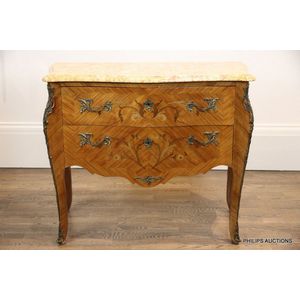
Inlaid Tulipwood Bombe Commode with Gilt Bronze Mounts
A Louis XV style inlaid tulipwood bombe commode, circa 1930, with a shaped yellow breche marble top above drawers with book end veneer, strung panels decorated with trailing floral motifs, the apron with drop and sharply hipped edges flowing to curvaceous…

Marquetry Inlaid Commode with Marble Top
A Louis XV style marquetry inlaid marble top commode 85 cm high, 125 cm wide, 54 cm deep

19th Century French Marble Top Commode
A Louis XV style marble top commode, French, 19th century 89 cm high, 123 cm wide, 62 cm deep

Louis XV Style Kingwood Bombe Commode with Gilt Bronze Mounts
A fine Louis XV style kingwood bombe commode, late 19th to early 20th century, with a serpentine breche d'Alep marble top above three drawers with shaped feather banded reserves with blonde and ebonised stringing, pronounced hipped edges and splayed legs,…

Inlaid Tulipwood Bombe Commode with Bronze Mounts
A Louis XV style inlaid tulipwood bombe commode, circa 1930, a shaped yellow breche marble top above two drawers with floral strung reserves, an apron with drop, hipped edges flowing to curvaceous legs, embellished with cast bronze mounts and sabots,…

Inlaid Tulipwood Commode with Yellow Marble Top
A Louis XV style inlaid tulipwood commode, circa 1930s, with a serpentine yellow breche marble top above two drawers with floral inlay to strung veneer panels, a pronounced drop, hipped edges and cabriole legs, with cast foliate handles, trims and sabots,…

French Louis XV Style Marble Top Commode with Inlay
Impressive early 20th century French marble topped Louis XV style three drawer commode, with brass mounts, inlaid decoration, 87 cm high, 120 cm wide, 53 deep

Louis XV Walnut Commode, Late 19th Century
A small Louis XV style walnut commode, late 19th century, of restrained decoration with three incised and carved drawers with pairs of laurel wreath cast handles, fielded panels to the sides, the apron with drop, and raised on slender cabriole legs,…

Louis XV Gilt Bronze Mounted Walnut Commode
A large Louis XV & gilt bronze mounted walnut marble top commode 87 cm high, 124 cm wide and 48 cm deep.

Louis XV Carved Fruitwood Bombe Commode
A Louis XV style carved fruitwood bombe commode 89 cm high, 120 cm wide, 67 cm deep

Louis XV Style Walnut Commode with Gilt Bronze Mounts
A Louis XV style walnut and kingwood gilt bronze mounted marble top commode 85 cm high, 97 cm wide and 48 cm deep

Louis XV Tulipwood Commode with Inlay and Gilt Bronze Mounts
A Louis XV style inlaid tulipwood commode, late 19th century, the commode of serpentine profile with a veined dark grey marble top above, three oak lined long drawers with bold vegetal inlay upon a darker toned, ground, decorated with cast gilt bronze…

Louis XV Tulipwood Commode with Gilt Bronze Mounts
A Louis XV tulipwood bombe commode, second half 20th century, a veined serpentine yellow marble top above three drawers with bookend veneer, reserves with stringing and floral inlay, the sides similarly decorated, having a shaped apron and drop, hipped…

Floral Marquetry Commode with Gilt Bronze Mounts
A Louis XV style bombe tulipwood and marquetry commode, circa 1930, a shaped mottled yellow marble top above two drawers with floral inlay to quarter veneer strung reserves, the sides conforming, with hipped edges and curved legs, embellished with…
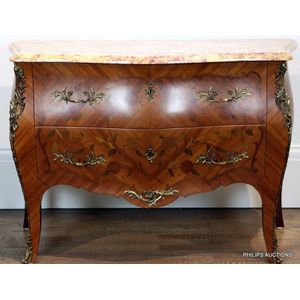
Louis XV Style Tulipwood Inlaid Bombe Commode
A large Louis XV style tulipwood inlaid bombe commode, circa 1930, with a mottled purple and ochre marble top of serpentine profile, two drawers decorated with floral marquetry to quarter veneer reserves, the sides conforming, hipped edges flowing to…

Louis XV Fruitwood Commode with Gilt Bronze Mounts
A very fine Louis XV commode, Parisian manufactured in matched fruitwood veneer, possibly olivewood. The D-shaped top elaborately crossbanded, masterly crafted with graduating tones and with central medallion, the ends with half-circle motifs. The commode…

Louis XV Parquetry Bombe Commode with Sunray Design
A Louis XV style parquetry bombe commode in mixed timbers, circa 1930, mark of Salonde Paris under marble, a mottled yellow ochre marble top of serpentine profile above two drawers, with a striking sunray design, the sides conforming, having a shaped…

Kingwood Bombe Commode with Gilt Bronze Mounts
A Louis XV style kingwood bombe commode, early 20th century, a mottled red marble top of serpentine profile above three drawers with, bookend veneers and inlaid floral bordered cartouches, the sides similarly, decorated, having a shaped apron with drop,…

Louis XV Style Painted Commode with Ormolu Mounts
A French ormolu mounted Louis XV style painted three drawer commode 78 cm high, 96 cm wide, 44 cm deep

Louis XV Walnut Commode with Marble Top
A French Louis XV style walnut serpentine shaped three drawer commode with shaped marble top, 83 cm high, 66 cm wide, 38 cm deep.

Louis XV Style Walnut Bombe Commode with Marble Top
A French Louis XV style walnut two drawer bombe shaped commode with rouge marble top, 87 cm high, 127 cm wide, 59 cm deep.

Louis XV Style Inlaid Marble Top Commode
A French Louis XV style kingwood and inlaid two drawer bombe shaped marble top commode, 89 cm high, 118 cm wide, 49 cm deep.

Floral Marquetry Commode with Marble Top
A French Louis XV style walnut and floral marquetry decorated bombe shaped two drawer marble top commode, 76 cm high, 79 cm wide, 39 cm deep.

Louis XV Style Marquetry Commode with Marble Top
A fine French Louis XV style kingwood and floral marquetry decorated three drawer commode with shaped marble top, 83 cm high, 114 cm wide, 54 cm deep.

Louis XV Walnut Parquetry Commode with Marble Top
A French Louis XV style walnut and parquetry decorated Serpentine shape three drawer marble top commode, 84 cm high, 98 cm wide, 42 cm deep.

Louis XV Style Kingwood Commode with Marble Top
A French Louis XV style kingwood and floral marquetry decorated three drawer marble top commode, 86 cm high, 83 cm wide, 38 cm deep.

Olive Wood Bombe Commode Chest - Louis XV Style
Louis XV style olive wood bombe commode chest with 2 short and 2 long drawers, 115 cm wide, 43 cm deep, 81 cm high approx

Louis XV Style Tulipwood Commode with Orange Marble Top
A Louis XV style tulipwood bombe commode, mid 20th century, with a vibrant orange crystalline marble top of shaped profile above a pair, of drawers and two long drawers with quarter veneer panels, with cross, banding and stringing, a shaped apron, hipped…

Marquetry Bombe Commode with Gilt Bronze Mounts
A Louis XV style tulipwood and marquetry bombe commode, mid 20th century, with a mottled yellow and purple marble top of shaped profile above two, drawers with parquetry decoration to shaped and strung reserves, the sides, conforming, a shaped apron,…

Inlaid Tulipwood Bombe Commode with Bronze Mounts
A Louis XV style inlaid tulipwood bombe commode, circa 1930, with a mottled purple top above two long drawers with floral inlay to quarter, veneer panelled reserves, the sides conforming, with hipped edges, a shaped, apron and curvaceous legs, with bronze…

Louis XV Style Inlaid Commode with Ormolu Mounts
Bombe commode Louis XV style, three drawers with marquetry inlay, ormolu mounts & marble top, height 84 cm, length 111 cm, depth 60 cm
 Loading more...
Loading more...